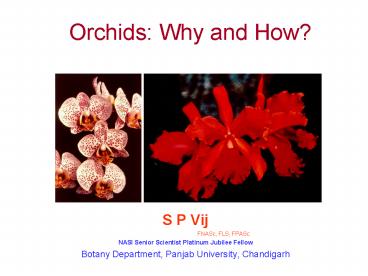Orchids: Why and How? - PowerPoint PPT Presentation
1 / 45
Title: Orchids: Why and How?
1
Orchids Why and How?
- S P Vij
-
FNASc, FLS, FPASc - NASI Senior Scientist Platinum Jubilee Fellow
- Botany Department, Panjab University, Chandigarh
2
ORCHIDS
Cosmopolitan
Highly diverse, evolved, under active speciation
Post pollination development of ovules
Inherently slow growers, habitat specific
Pollination related floral complexities
Non-endospermic, minute seeds, reduced embryos
Ill-defined barriers of reproductive isolation
Mycotrophic
8 flowering plant species 60 Monocots
3
ORIGIN
Poor Fossil History Antholithes, Paleorchis,
Protorchis, Orchidacites
Where
When
South East Asia
80-40 million years ago
Cretaceous
Coenozoic
Paleocene
Eocene
4
Proplebeia domoinicana carrying Meliorchis
caribea pollen load
5
ANCESTRY
Suggested Ancestors
Bromeliaceae Commelinaceae Iridaceae
Burmaniaceae Hypoxidaceae
Asparagales Liliales
6
HABIT
7
HABITAT
Terrestrial
Lithophytic
Epiphytic
Subterranean
- Major speciation around epiphytic mode
- Substratum dynamics and adaptive flexibility
- 73 species epiphytes
8
(No Transcript)
9
(No Transcript)
10
(No Transcript)
11
(No Transcript)
12
(No Transcript)
13
FLOWERS
- Myriad sizes, shapes, colours
- Labellum
- Compound pollen
- Resupination
- Non-resupinated
Caleana,Malaxis, - Oberonia, Satyrium
- Bisexual
- Unisexual
- Catasetum,Cycnoches,
- Satyrium
14
FLORAL EVOLUTION
15
(No Transcript)
16
(No Transcript)
17
(No Transcript)
18
MYCOTROPHY
19
(No Transcript)
20
CARNIVORE !
21
MYRMECOTROPHY
- Mutualistic Association
- Ants
- Disperse seeds, pollen
- Provide nutrition
- Ward off herbivores
- Orchids
- Provide shelter
- Extra-floral nectar
All visiting ants not pollinators
22
POLLINATION
- Cleistogamy Phaius tankervillae, Zeuxine
membranacea - Chasmogamy most orchids
- Autogamy several terrestrial orchids (Ophrys)
- Allogamy most orchids
23
ALLOGAMY
- Entomophily (insects) Most orchids
- Melittophily (bees/wasps)
Catasetum 60 - Myophily (flies) Disa lugens 15
- Phalaenophily (moths) Brassavola nodosa 8
- Psychophily (butterflies) Disa uniflora 3
- Ornithophily (Birds) Comparettia falcata 3
- Cantarophily (beetles) Herminium monorchis
- Myrmecophily (ants) Microtis
parviflora 8 - Batrachophily (frogs) Lissochilus roseus
- Monophily Many orchids
- Promiscuity Some orchids
24
ATTRACTANTS
- Nectar (nectar tubes, spurs)
- Glucose, fructose, sucrose
- Callus masses (unicellular trichomes, papillae,
scales) - Starch, proteins, oil drops, fragrance
- Colours Odours Pollinator(s)
- Several (seldom red) Sweet Bees
- Bright red, orange, yellow Pleasant Butterflie
s - Pale-green, cream, white Sweet, strong Moths
- Bright, yellow, red, pink None Birds
- Yellow, green, red, purple Sweet Flies
25
(No Transcript)
26
(No Transcript)
27
(No Transcript)
28
(No Transcript)
29
(No Transcript)
30
DECEITS
- Pseudonectaries Odontoglossum kegeljani
- Pseudopollen Maxillaria, Polystachya
- Simulation of fungus Cypripedium
debile, Corybas, Dracula - Simulation of sexual Cryptostylis,
Ophrys, - partners
Trichoceros, Oncidium - pseudocopulation
- (preferentially directed
towards male insects - due to their weaker
feeding instincts)
31
(No Transcript)
32
ORCHID POLLINATORS
- Sub-Family Pollinators
- Apostasioideae
Not known - Cypripedioideae Bees, flies
- Neottioideae Fungal gnats, wasps, bees,
- Orchidoideae Moths, butterflies, bees, wasps
- Epidendroideae Bees, wasps, butterflies,
flies, moths, ants, fungal gnats,
beetles, birds -
pseudocopulation
33
ROBBERS
34
THERAPEUTICALLY IMPORTANT ORCHIDS
35
(No Transcript)
36
(No Transcript)
37
Floricultural importance
- FLOWERS
- Intricately fabricated
- Long-lasting
- Beautiful, fragrant
- Colourful
- myriad shapes, sizes
38
VALUE ADDITION
- Hybridization
- pollen transfer in toto
- seeds numerous
- suppressed development of endosperm
- gt100,000 man-made hybrids
- Control of flower induction
- Genetic transformations
39
Floral excellence
40
(No Transcript)
41
(No Transcript)
42
(No Transcript)
43
(No Transcript)
44
Some Facts About Orchids
- First discovery of nucleus Robert Brown,
1833 - Largest Flower Paphiopedilum
sanderianum (176.6 cm) - Tallest orchid Sobralia
altissima (41/) - Most floriferous orchid Ceratostylis
rubra (3000 flowers in 425 -
inflorescences) - Subterranean orchid Rhizanthella
- Carnivorous orchid
Schomburgkia tibicinis - Maximum no. of seeds Cycnoches
chlorochilon - Maximum days for fruit Cymbidium
(550) - development
45
- THANK YOU































